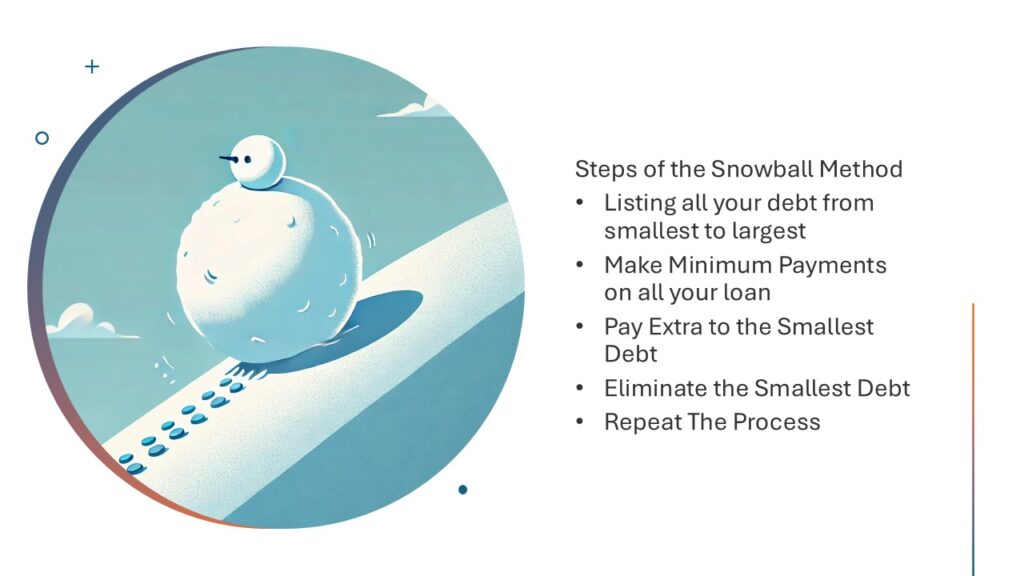Introduction
When it comes to paying off debt, it’s easy to feel overwhelmed, especially if you have multiple debts to manage. The Snowball Method is a popular strategy that helps you tackle your debt in a way that feels manageable and motivating. This method focuses on paying off your smallest debts first, giving you quick wins that can boost your confidence and keep you on track. Let’s dive into how the Snowball Method works and why it might be the right approach for you.
What Is the Snowball Method?
The Snowball Method is a debt repayment strategy where you focus on paying off your smallest debts first, regardless of the interest rates. You continue making minimum payments on all your other debts. However, any extra money you have goes toward paying off the smallest debt. Once that debt is paid off, you move on to the next smallest debt, and so on. This method is called the “Snowball Method” because your progress builds momentum as you go, similar to a snowball rolling down a hill.
Historical Background
The Snowball Method of debt repayment became really popular thanks to Dave Ramsey. He is a well-known personal finance expert, author, and radio show host. Even though the idea of paying off smaller debts first to build momentum has been around for a while, Dave Ramsey is the one who gave it the name “Snowball Method” and made it famous. He made this method a key part of his “Baby Steps” program. This program is a step-by-step plan to help people manage their money and achieve financial freedom.
How Does the Snowball Method Work?

Here’s a step-by-step breakdown of how the Snowball Method works:
- List All Your Debts: To begin with, start by listing all your debts from smallest to largest balance. Don’t worry about the interest rates—just focus on the balance amount.
- Make Minimum Payments: Then, continue making minimum payments on all your debts to avoid late fees and penalties.
- Pay Extra on the Smallest Debt: Any extra money you can put toward debt repayment should go to your smallest debt. This could be extra income from a side job, bonuses, or even money saved by cutting back on non-essential expenses.
- Eliminate the Smallest Debt: Once you’ve paid off the smallest debt, cross it off your list. Then, take the money you were putting toward that debt and apply it to the next smallest one.
- Repeat the Process: Continue this process until you pay off all your debts. As you eliminate each debt, your momentum will grow, making it easier to tackle the larger ones.
Why the Snowball Method Works
The Snowball Method works because it gives you small, achievable goals that help build your confidence. Paying off a debt—no matter how small—feels like a win, and that positive reinforcement can keep you motivated to stick with your debt repayment plan. This method is especially helpful for those who need that extra boost of motivation to stay focused.
Another reason the Snowball Method is effective is that it simplifies the debt repayment process. By focusing on one debt at a time, you reduce the stress of juggling multiple debts and can more easily track your progress. This simplicity makes it easier to stick with the plan, even when the going gets tough.
Pros and Cons of the Snowball Method
Like any strategy, the Snowball Method has its pros and cons. It’s important to consider these before deciding if it’s the right approach for you.
Pros:
- Quick Wins: By paying off smaller debts first, you get a sense of accomplishment that keeps you motivated.
- Simple to Follow: The Snowball Method is easy to understand and doesn’t require complicated calculations.
- Boosts Confidence: Seeing your debts disappear one by one can give you the confidence to tackle larger debts.
Cons:
- Potentially Higher Interest Costs: Since you’re not focusing on the debts with the highest interest rates, you might end up paying more in interest over time.
- May Take Longer to Pay Off: Depending on your debt situation, the Snowball Method might take longer to eliminate all your debt compared to other strategies.
Is the Snowball Method Right for You?
The Snowball Method is a great option for people who need a simple, straightforward approach to debt repayment. It’s particularly effective if you benefit from seeing quick results and need that extra motivation to stay on track. However, if your main goal is to save money on interest, you might want to consider the Avalanche Method. This method focuses on paying off debts with the highest interest rates first.
Practical Example of How Snowball Method Works
Let’s imagine a student named Alex who has $100,000 in student loans from different sources. The loans have different balances and interest rates. Here’s a breakdown of Alex’s loans:
| Loan | Amount (In Dollar) | Interest (%) |
| Loan A | 5,000 | 5 |
| Loan B | 15,000 | 4 |
| Loan C | 10,000 | 6 |
| Loan D | 20,000 | 7 |
| Loan E | 50,000 | 3 |
Applying the Snowball Method
With the Snowball Method, Alex will focus on paying off the smallest loan first, while making minimum payments on the others. Let’s see how Alex could approach this:
Step 1: List All Loans by Balance (Smallest to Largest)
| Loan | Amount | Interest |
| Loan A | $ 5, 000 | 5% |
| Loan C | $ 10, 000 | 6% |
| Loan B | $ 15, 000 | 4% |
| Loan D | $ 20, 000 | 7% |
| Loan E | $ 50, 000 | 3% |
Download the Snowball Method Spreadsheet
Step 2: Make Minimum Payments on All Loans
Alex will continue making the minimum required payments on all the loans to avoid any late fees or penalties.
Step 3: Focus Extra Payments on the Smallest Loan
- Loan A: Alex will pay as much extra as possible toward this $5,000 loan while making minimum payments on the others. Let’s say Alex can contribute an extra $500 per month to debt repayment.
- Within approximately 10 months, Alex will pay off Loan A.
Step 4: Move on to the Next Smallest Loan
- Loan C: Now that Loan A is paid off, Alex will take the $500 plus the minimum payment that was being made on Loan A and apply it to Loan C.
- Over time, Loan C will be paid off, and Alex can move on to the next loan.
Step 5: Continue the Process
- Loan B: After Loan C is paid off, Alex adds the payments from Loan A and Loan C to the minimum payment on Loan B, accelerating its payoff. The process continues until Alex pays off all his loan
How It Works for Alex
As Alex pays off each loan, the total monthly amount available to put toward debt increases, creating a “snowball” effect. While Loan E is the largest and will take the longest to pay off, the sense of accomplishment from paying off the smaller loans keeps Alex motivated to continue.
In this scenario, the Snowball Method helps Alex stay focused and make consistent progress toward becoming debt-free, starting with the smallest loans and building momentum as each one is paid off.
Conclusion
The Snowball Method of debt repayment is a powerful tool that can help you regain control of your finances. By focusing on paying off your smallest debts first, you can build momentum and stay motivated throughout your debt repayment journey. While it may not be the fastest or cheapest method in terms of interest costs, its simplicity and psychological benefits make it a popular choice for many people.
Moreover, as you pay off each small debt, you’ll free up more money to put toward your larger debts. This, in turn, can accelerate your progress. Additionally, the sense of accomplishment you gain from clearing debts can boost your confidence. As a result, it can make it easier to stick to your plan. Ultimately, if you’re looking for a debt repayment strategy that’s easy to follow and keeps you motivated, the Snowball Method might be just what you need. In conclusion, it can help you start rolling toward a debt-free future.

